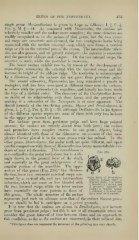Page 465 - My FlipBook
P. 465
TEETH OF THE VERTEBRATA. 475
single genus 3Ieniscotherium is given by Cope as follows : I. |, C.
]-,
Pni. |, M. = 44. As compared with Phenacodns, the canines are
f
relatively smaller and the molars more complex ; the same elements are
readily recognized as in the molars of that genus, but the two exter-
nal cusps are crescentic and elevated, the two contiguous horns being
connected with the median external cusp, which now forms a vertical
ridge or rib on the external part of the crown. The intermediate tuber-
cles are also present, and are greatly enlarged ; the anterior is crescentic
and the posterior oblique and elongate. Of the two internal cusps, the
anterior is conic, while the posterior is crescentic.
The lower molars exhibit two Vs, by reason of the development of
cross-ridges connecting the external with the internal cusps and tlie
increase in height of the oblique ridge. The tooth-line is uninterrupted
by a diastema, and the incisors did not grow from persistent pulps.
The second sub-order, Hyracoidea, has long remained a puzzle to
zoologists, and has been associated at different times near the rodents,
at others with the perissodactyle ungulates, and latterly has been made
the type of a distinct order. The discovery of the Condylarthra leaves
no doubt of its relationship with these forms, and the propriety of
making it a sub-order of the Taxeopoda is at once apparent. The
dental formula of the two living genera, Hyrux and Dendrohi/rax, is
given, I. f , C. ^, Pm. ^, M. | = 36, although DeBlainville in his figures
of the diifercnt species represents some of them with only two incisors
in the upper jaw instead of four.
The incisors grow^ from persistent pulps and have large pointed
crowns ; the canines are entirely absent from both jaws ; the molars
and premolars have complex crowns—in one genus, Hyrax, being
almost identical with those of the rhinoceros ; on account of this com-
plexity Cuvier placed it in the same group with tliat animal. In the
other genus, Deudrohyrax, the molar teeth are quite different, and upon
careful comparison with those of 3Ienlscotherlum betray unmistakable evi-
dence of near relationshii). This resemblance is „ «--
not confined to tlie molar teeth alone, but is strik-
ingly sliown in the general form of the skull,
and especially in the great enlargement of tlie
angular portion of the mandible. The upper
molars of this genus (Fig. 255),^ like Menisco-
therium, have two crescentic external cusps con-
nected by a vertical rib, and two intermediate
^^°!^6L-.T'rverficai'fi'^wf''r^
tubercles, which are more or less blended with superior moiar; i.extemaij
- '. - 1 M ' interior, 3, internal, and
1
1
1
the two internal cusps, wliile the lower molars 4, posterior surfaces or
1 J- 11 j1 ij_ J.1 r crown; &, inferior molar;
nave essentiallv the same pattern as those ot 1, external, 2, internal sur-
this genus. The whole structure of the molars ^^'^' '^"^'' ^' Bi'''""i"e)-
represents just such an advance over that of the extinct Eocene genus
as we should be led to anticipate on a priori grounds.
It is true that the canines are absent in Dendrohyrax, and incisors
grow from persistent pulps ; but this is not at all remarkal^le w^hen we
consider the great interval of time between them and an approach to
this condition, as far as the canines are concerned, in their reduced size,
' This figvire does not represent the structure of the grinding face very clearly.


